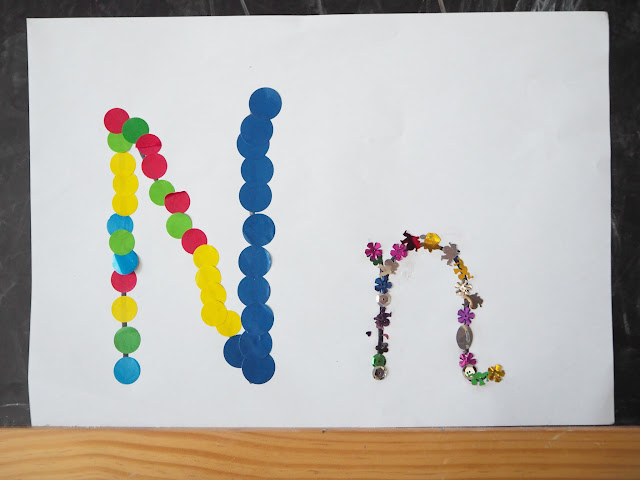Letters are a hot topic at our house these days. Noah (3.5) has taken a real interest in letters, pointing them out, asking about their names and sounds and making connections between letters and other people or things in his life. Now is the perfect time for me to build upon this interest and offer opportunities for him to practice reading, writing, tracing, sounding-out, recognising, playing with and experiencing letters.
At this age especially, I believe learning should be enjoyable and not forced. You can read more about my thoughts on learning letters with younger children here and how best to go about it here.
Today's activity works specifically on letter recognition, letter formation, fine motor skills and name recognition.
Ages: 2+
See the bottom of the post for handy tips for getting the most out of this activity for your child/ren
Materials:
- Paper
- Marker
- Dot stickers (or other small stickers)
- sequins (optional)
- glue (optional)
With this activity you could focus on one letter at a time or on whole words. The letters in your child's name are a good starting point. The objective of this activity is for children to cover the lines with their stickers to make a sticker letter (or word). I like to include both the capital and lower-case letter. I see no reason these two cannot be learnt hand-in-hand.
You can offer this activity to your child as an "Invitation to Play." Having an enticing set-up where children can get an idea of how they can jump right in is likely to encourage them to want to participate.
Younger children will find it challenging to just line up the stickers on the line. Children require practice and time to work on things like spacing and hand-eye coordination which this activity encourages.
Concentration and fine-motor skills required to peel off little stickers.
Concentration, thought and coordination required to place the stickers along the line consecutively.
Children (like us) feel pride and joy felt when they experience success.
To mix things up a bit I included a glue-stick and a little bowl of sequins.
Sequins are great for working fine-motor skills and encourage children to use the pincer grasp (picking things up between thumb and index finger). They are also shiney and lots of different shapes and sizes which makes them appealing to children.
As well as focusing on individual letters, you could also focus on your child's name.
Handy Tips:
- Simplify for younger children by only focusing on the one letter at a time and by making your letter smaller so that fewer stickers are needed to cover the lines. Encourage them to really look at placing the sticker on the line and at the spaces between each sticker. You may need to help them peel the stickers off.
- Extend this activity by:
- Encouraging children to attempt to write the letter first before covering it with the stickers or sequins. When focusing on writing the letter, show children the correct starting point and direction they should write the letter so that they get used to doing it the right way. Alternatively, you could lightly draw in the letter and allow them to trace over it first.
- Having children brainstorm things that start with that letter and draw them around their covered letter.
- Going on a letter scavenger hunt to find items that begin with the letter you're working on.
- Mix it up by covering your letters with a range of different materials. Try gluing on glitter, pasta, material, paper scraps, etc.
- Good to Know. If you are practicing handwriting at home, I would be finding out how they teach it at your local schools so that your child can learn it the same way. It can be difficult re-teaching children how to do it the expected way so if they learn correctly from the beginning it's much easier. Obviously your children will experience text in all different forms and be exposed to a huge variety of fonts that they will need to recognise but it will make it easier in the long run if they learn to write the letters in the expected way to begin with. (ie, here in Victoria, schools use "Victorian Cursive" which is what I use when working on letters/words/writing with my children)
- Talk with your child about what they are doing while they are doing it. Encourage children to name the letter and the sounds it makes. Brainstorm words that begin with your chosen letter and look out for that letter on signs or other print they are exposed to.
- Check out our other posts for Learning Letters
- The A-Z of Learning Letters. 90+ hands on Letter Learning Activities
- 10 Activities for Learning Letters
- 2 fun Salt Tray Letter Games
- Play and Learn: Magnetic Letters and Playdough
- Play and Learn: Rice and Magnetic Letters
- Alphabet Goo
- Learning Letters
Happy playing,
Debs :)
Look where else we are. Are you following along? :)
New Here? Subscribe to get all activities sent directly to you













